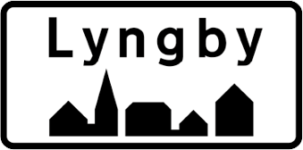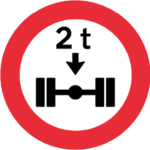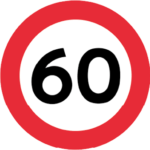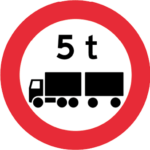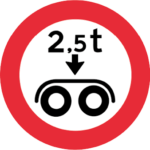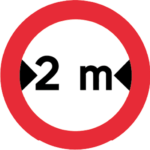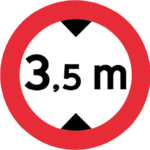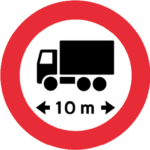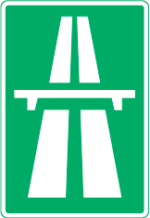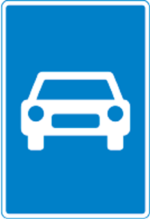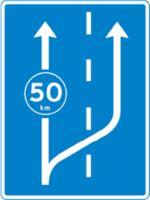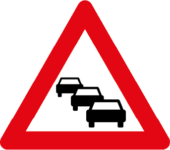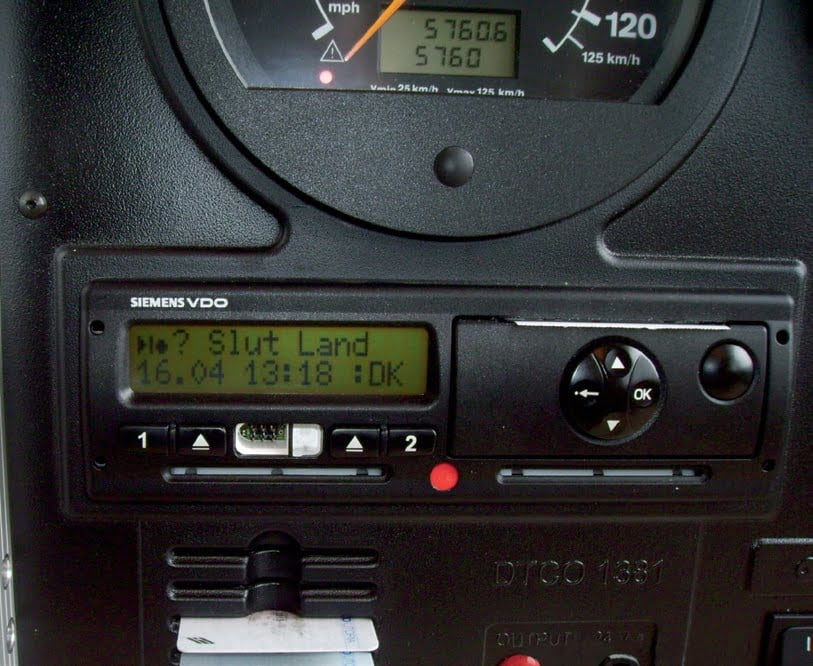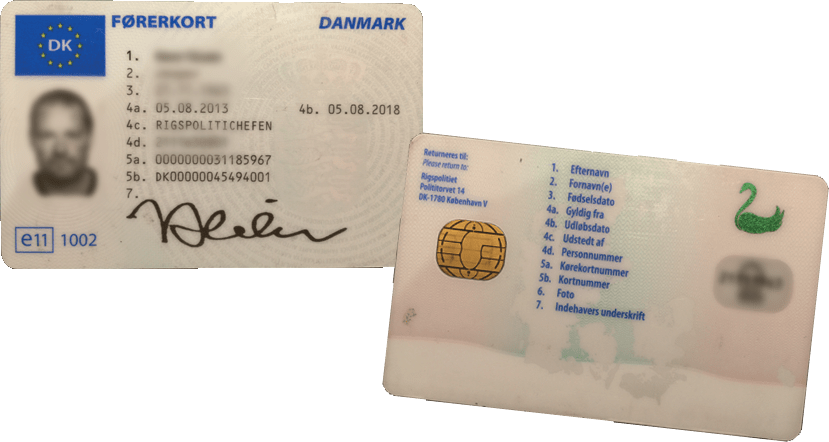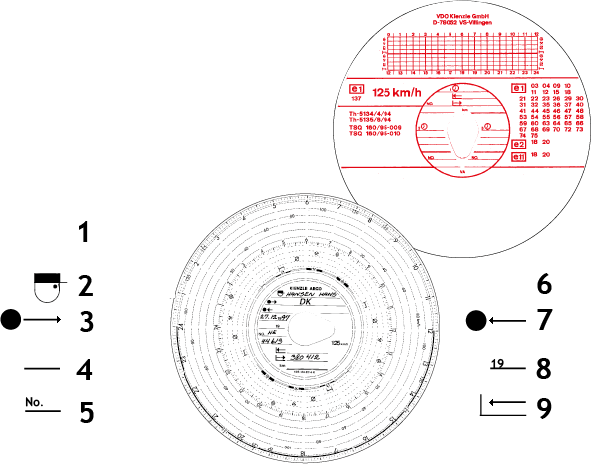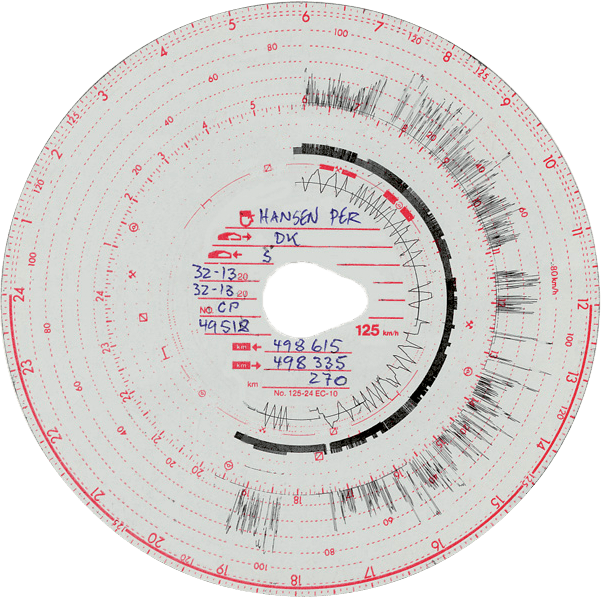Trailer
Driving school
theory book
for category B+ and BE
Road signs and traffic rules that are particularly relevant when driving with a trailer.
§ Speed: The main rule is that the driving speed must always be adapted to the conditions, with special consideration for the safety of others, and you must never drive faster than you can maintain full control of the vehicle. For a normal car with a trailer attached, the speed must not exceed 80 km/h. On motorways, however, 100 km/h. With 100 km/h authorisation.
Motorways and expressways may not be used when towing an unregistered trailer. If there are three or more lanes in the same direction on a motorway or expressway, cars with a maximum permissible weight of more than 3500 kg and road trains longer than 7 m may only use one of the two rightmost lanes. However, this does not apply if the placement in the third lane is a necessary preparation for turning or merging.
Towing another vehicle is totally prohibited.
The sign indicates a specific lane to be used by vehicles,
travelling at a lower speed than that indicated for the rest of the lane.
Speeding offences
For any violation of applicable speed regulations, the penalty range will typically be:
"Minor" overrun = fine
Exceeding more than 40% = fine,
Suspended driving licence and a controlled driving test
(theory test and practical driving test).
REMEMBER that the speed with an unregistered trailer
(e.g. a wood splitter) is a maximum of 30 kilometres per hour.
REMEMBER that 3 "clips" within 3 years will result in a conditional disqualification
speeding over 30% results in 1 "clip".
The sign warns of a particular risk of congestion and is used in places where dangerous congestion is likely to occur. Will normally only appear on roads with high traffic intensity outside urban areas. Remember to pay special attention and keep a safe distance from those in front.
Hazard warning lights MUST be used in the event of unexpected congestion or other immediate danger on a motorway.
Emergency flashers MAY be used in the event of unexpected traffic jams or other immediate danger on other road types.
Control device (speed discs).
That the recording equipment must be used in a vehicle whose maximum authorised total weight including trailer or semi-trailer exceeds 3,500 kg. However, according to the EU regulation and executive order on driving and rest periods in road transport, certain vehicles are exempt from the driving and rest period regulations. If recording equipment is to be used, the regulations on recording equipment and the regulations on driving and resting times for the driver must be strictly observed. Violations can result in fines and disqualification from driving. The details of the recording equipment are laid down in the Regulation of the European Parliament and of the Council on the harmonisation of certain social legislation relating to road transport and the Council Regulation on recording equipment in road transport.
For cars first registered after January 2007, the recording equipment must be a tachograph (digital tachograph), which requires a tachograph card issued by the police.
Tractor units (e.g. vans with trailers) with a maximum authorised weight of more than 3500 kg and used to transport goods must be equipped with a recording device. The purpose of the device is to record how fast and how far the vehicle has travelled and when and for how long it has stopped. The purpose is to be able to check whether the driving and rest time regulations have been complied with during a certain period. The following regulations apply to the tachograph and its operation:
Driving time:
Driving time is the time recorded by a recording device as driving.
The daily driving time between two daily rest periods must not exceed 9 hours. Twice during a week, the daily driving time can be increased to a maximum of 10 hours. The weekly driving time must not exceed 56 hours. The sum of the driving times in 2 consecutive weeks must not exceed 90 hours.
Driving time without a break:
A driving time without breaks must not exceed 4.5 hours, after which a continuous break of at least 45 minutes must be taken, unless the driver starts a rest period. This break may be replaced by a break of at least 15 minutes, followed by a break of at least 30 minutes spread over the driving period. The order of the breaks cannot be swapped. For two-man operation, the break can be taken in a moving vehicle. The driver must not perform any driving or other work during this break.
Rest time:
Within any period of 24 hours after the end of the previous daily or weekly rest period, the driver must have taken a regular daily rest period of at least 11 consecutive hours (regular daily rest period). The regular daily rest period can be taken in 2 periods, the first of which must be at least 3 consecutive hours and the second at least 9 consecutive hours. The rest period can be reduced to at least 9 consecutive hours (reduced daily rest period) up to 3 times between two weekly rest periods. If there are multiple drivers in the vehicle, each driver must have a daily rest period of at least 9 consecutive hours within a 30-hour period. A regular daily rest period taken while accompanying a vehicle on board a ferry or train shall not be interrupted more than twice by other activities for a total of more than one hour. The driver must have access to a bunk or berth.
For two consecutive weeks, the driver must take at least:
a) 2 regular weekly rest periods of at least 45 hours each; or
b) a regular weekly rest period of at least 45 hours and a reduced weekly rest period of at least 24 hours. The reduced time, e.g. 21 hours (regular weekly rest of 45 hours minus reduced weekly rest of 24 hours) must be compensated with an equivalent rest to be taken in total within three weeks after the end of the week in question.
Rest taken as compensation for reduced weekly rest must be taken in continuation of another rest period of at least 9 hours. In the example of a reduced weekly rest period of 24 hours, the compensation must be at least 30 hours (reduction of 21 hours plus 9 hours). A weekly rest period must start no later than the end of 6 consecutive 24-hour periods after the end of the previous weekly rest period. Daily rest periods and reduced weekly rest periods taken away from home can be taken in the vehicle if it is equipped with adequate sleeping facilities for each driver and the vehicle is stationary. The back of the diagram disc is only filled in in the event of a malfunction of the device or in the event of a change to another vehicle.
1. Fill in the diagram disc before starting the journey:
2. Last name and first name.
3. Country where the journey begins.
4. Date of the start of the trip.
5. registration number.
6. The chart disc is terminated on return home:
7. Location where the tour ends.
8.Date of the end of the trip,
9. Mileage at the end of the trip.
Using the control device:
The recording equipment can either be analogue with a chart sheet or digital with a tachograph card. An analogue recording device records the driver's activities on a chart sheet. A digital recording device records the driver's activities partly on a tachograph card and partly in the recording device. In certain special cases, such as damage or theft of the tachograph card, it may be necessary to use a printout from the digital recording equipment to record the driver's activities. Chart sheets/tachograph cards must be used every day from the moment the vehicle is taken over until the end of the daily work period. If chart sheets are used, a sheet that fits the recording device must be used. This is ensured by looking at the printed numbers on the back of the chart sheet, where one number must correspond to the number on the recording equipment nameplate.
Before inserting the diagram sheet into the recording equipment, the driver must clearly and legibly record the following information on the sheet:
a) Last name and first name. Initials are not sufficient and stamps must not be used.
b) Start date and start location. Start location can be specified either by country code (e.g. DK) or country (e.g. Denmark) or city name (e.g. Esbjerg).
c) Registration number of the vehicle to be used. When changing vehicles during the work period, the registration number of each subsequent vehicle must be entered in sequence on the back of the sheet.
d) Odometer reading at the start time. When changing vehicles during the work period, the first vehicle's final kilometres must be entered on the front and the new vehicle's starting kilometres must be entered on the back together with the new registration number.
e) The time of the vehicle change. The time is indicated on the back of the chart sheet.
The end date, end location and mileage must be recorded on the record sheet when it is no longer needed. The driver must operate the recording equipment's setting buttons so that all time groups (driving time, other work, availability and rest) are recorded and the driver's activities can be clearly seen on the tachograph chart/data on tachograph cards and in the digital recording equipment and on any printouts. The chart sheet may only be replaced at the end of the daily work period. However, the tachograph card may be removed when changing vehicles or when the tachograph card is not expected to be used again in the same vehicle. The tachograph card may only be removed at the end of the daily work period. However, the tachograph card can be removed when changing vehicles or when the tachograph card is not expected to be used again in the same vehicle. The tachograph card may remain in the recording equipment for a maximum of 24 hours. The tachograph sheet and driver card and all manual registrations and printouts for the day in question and the previous 28 calendar days must be carried during the journey and must be presented to the police on request. If the recording equipment malfunctions or malfunctions, the driver must record on the record sheet or on a special sheet attached to either the record sheet or tachograph card all the information that the recording equipment would otherwise have recorded.
Disc showing a typical working day!
a) The driver inserts the disc when taking over the vehicle (registration started). Last name and first name, place of departure (nationality letters), vehicle registration number, date and odometer reading are recorded.
b) The pin records the day's driving (speed and any stops (loading and unloading) and any stops in traffic).
c) Break for at least 15 min. (Always taken as 1st break).
d) Break for at least 30 min. (Always taken as a 2nd break) (The two breaks could also be taken as one combined break of at least 45 minutes). Then drive again for a maximum total of 4.5 hours. (Normally maximum driving time 9 hours per day).
e) Twice a week you can drive one extra driving hour. Please note that an extra break of at least 45 minutes must be taken beforehand (so twice a week you can drive 10 hours).
The disc (chart sheet) is taken at the earliest at the end of working hours, at a change of vehicle or after 24 hours.
The driver enters the end location, date and odometer reading and finally calculates the number of kilometres driven. (The disc is brought along for the driving day and the previous 28 calendar days and then handed in to the employer).
NB: If resting in the vehicle, it is recommended that a disc starts with rest (usually 11 hours). The digital tachograph records the driver's driving in the same way as the analogue tachograph.
Test your knowledge
Cat. B+ and BE - Section 7
Select the questions you think are the right ones.
